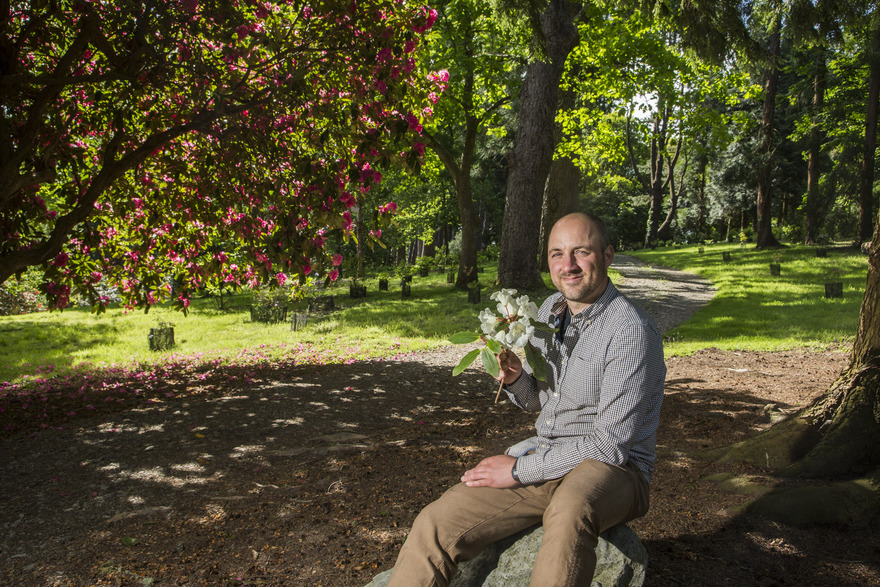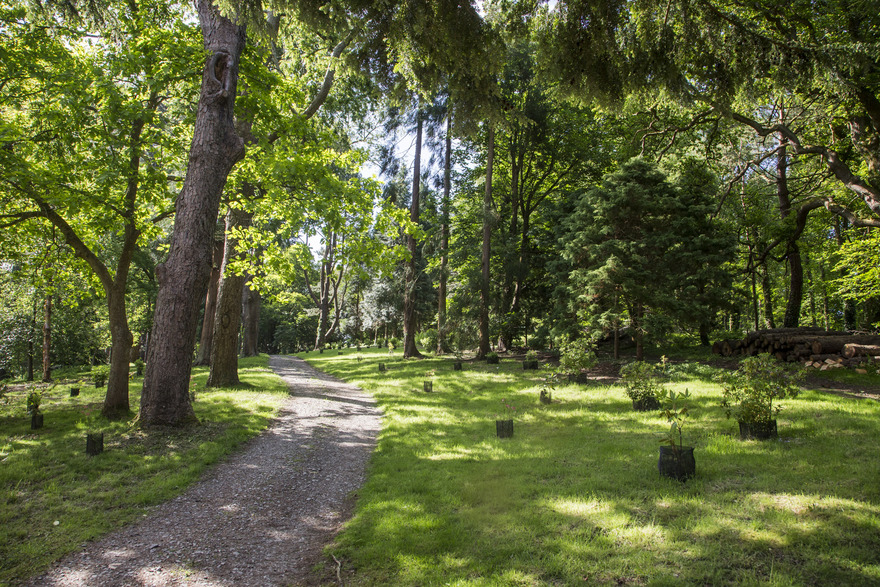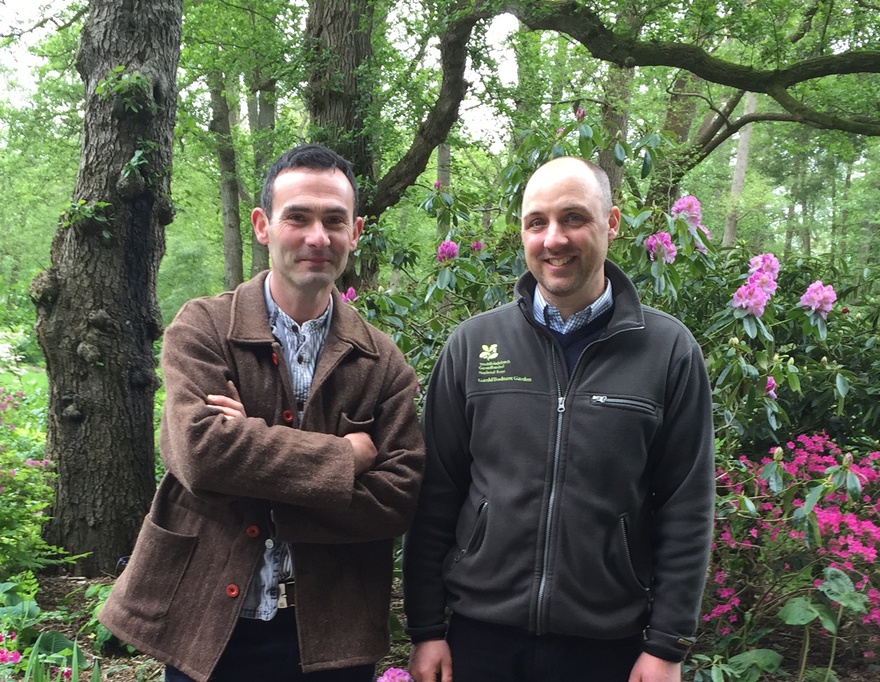National Trust Wales has revealed its vision for the next stage of Bodnant Garden’s ongoing restoration.
Penjerrick Walk will be a rare floral showstopper just as impressive as its famous Laburnum Arch.
Drawing in around 50,000 visitors for the three weeks it is in bloom, the Laburnum Arch is currently Bodnant Garden’s horticultural marvel. The earliest and longest of its kind in Britain at 55 metres, the Laburnum Arch is a flamboyant display of golden flowers.
The 100-metre-long, Penjerrick Walk forms part of Furnace Hill, a secret part of the 80 acre garden overlooking the River Hiraethlyn and the grand house. It will open to the public for the first time in spring 2017, creating an extra 20 acres for visitors to explore.
Penjerrick Walk is a recreation of the avenue of creamy white hybrid Rhododendron ‘Penjerrick’ that was originally planted by Henry McLaren. Former Head Gardener at Bodnant, Troy Smith, was inspired to reinstate the Walk after discovering a speech written for the Royal Horticultural Society by Henry McLaren, 2nd Lord Aberconway, from 1950.
“If I could switch the clock to any season of the year to enjoy a two minute walk at Bodnant, my choice would be the Penjerrick Walk in the first week of May”

Troy’s successor John Rippin, is now helping to turn the idea into a reality. The Rhododendron originates from the Himalayas and the Penjerrick is a rare hybrid bred at Penjerrick Garden in Cornwall. With the help from the Rhododendron, Camellia and Magnolia Group of the RHS, the team at Bodnant has been able to micropropogate plant material from the remaining Penjerricks at the garden at a specialist laboratory in Duchy College, Cornwall. The plants which are currently no more than 60cm high are expected to be in full bloom within ten years.
John aid: “We have many thousands of rhododendron species from across the world at Bodnant Garden and the team goes to great lengths to conserve and tend to the plants to ensure the grounds look incredible all year round. The Penjerrick is an especially significant plant to the history of the garden and is a rare breed within its species. Since 2012 the team here has opened up four new parts of the garden and we can’t wait to open Furnace Hill for visitors and will be eagerly waiting for the Penjerrick Walk to come into full bloom. The support from Duchy College and the RHS has been invaluable in making this happen.”

Justin Albert, director of National Trust Wales said: “Collected by intrepid plant hunters from as far back as 300 years ago, our precious plant life stands as testament to the vision and passion for plants shared by generations of owners and gardeners.
“This fantastic project at Bodnant Garden is just one of the many and varied conservation projects that our teams of gardeners and volunteers are undertaking at our gardens across Wales to restore and preserve plants from across the world for visitors to enjoy. Our ultimate goal is to look to return rare species we have conserved back to their places of origin, such as the Chinese Acer griseum found in Dyffryn, brought from China by the famous plant hunter Ernest Wilson.”
“We really do offer a world of gardens within Wales and June is one of the best times to see our gardens in all their glory, so we hope by sharing the stories of our rare plants we will inspire people to visit.”
The artist’s impression of how Penjerrick Walk will look has been released as a part of a wider campaign to encourage people to explore National Trust Gardens throughout June. To help garden enthusiasts to plan their World of Gardens journey, National Trust Wales has created a guide showing the origins of the huge variety of plants and flowers found in National Trust gardens.

DOWNLOAD your National Trust World of Gardens Guide and see how many varieties of flowers from different continents around the world you can spot at sites across Wales this spring: nationaltrust.org.uk/wales
Top 10 most exotic plants across the world and where you can find them in Wales
1. Redwoods giant trees originally from the United States are easy to spot in the Dell at Bodnant Garden or at Tredegar House
2. The bright red flowers of the Chilean firebush are hard to miss when they blossom in June; they’re currently growing in Bodnant Garden and at Chirk Castle
3. The Woodwardia radicans from the Atlantic Islands are better known as Chain Ferns. When the plantlets grow at Powis Castle touch the ground they root and continue to grow, hence their namesake
4. The Crown imperial fritillary flowers from Iraq can be found growing at Dyffryn Gardens and are named so due to an array of orange or yellow bell-shaped flowers that grow under a crown of leaves
5. One of the many Champion trees at Colby Woodland Garden is the Japanese red cedar, it currently stands tall at 130 feet
6. The Tasmanian flax lily is evergreen at Plas yn Rhiw due to the mild climate. The plants are common in Australian garden.
7. The Deodar cedars standing at Erddig are originally from the Himalayas. The name deodar comes from the Sanskrit word ‘devdar’, which means ‘timber of the gods’
8. Acer palmatum plants are originally from Japan and are now growing at Plas Newydd. They are grown worldwide for their attractive leaf shapes and colours and are a popular choice for Bonsai enthusiasts
9. Bodnant Garden is home to some of the earliest Magnolias introduced to Britain from China, you can now find them growing up the terrace walls
10. The Blue atlas cedars growing at Erddig were brought to the estate as seeds by Simon III; they’re easily recognizable due to the blue tinge of their needles
History of Bodnant Garden
• Bodnant is a world famous garden, home to national collections and champion trees created over 140 years.
• Founded in 1874 and developed by five generations of one family, it was gifted to the care of the National Trust in 1949.
• The garden spans 80 acres of hillside and is stocked with plants from around the world.
• The garden is also celebrated for its link to the plant hunters of the late 1800s, whose expeditions formed the base of the garden’s four national collections of plants- Magnolia, Embothrium, Eucryphia and Rhododendron forrestii.
• The garden’s founder was Henry Davis Pochin, a Leicestershire born Victorian industrial chemist. He became a successful businessman and bought the estate in 1874.
• Henry employed Edward Milner, apprentice to Joseph Paxton, to redesign the land around the existing house. Together they re-landscaped the hillside and valley, planting American and Indian conifers on the banks of the river Hiraethlyn to create a Pinetum, and reinforcing stream banks to create a woodland water garden in the valley.
• In the upper garden they created the Laburnum Arch and glasshouses, to house exotic plant varieties.
• Henry’s daughter, Laura McLaren Baroness Aberconway, continued the development of the garden. She was a passionate gardener who in turn inspired her son Henry McLaren to whom she entrusted the care of the garden in 1901.
• Henry McLaren sponsored plant hunting expeditions by explorers who brought back plants from China and the Himalayans including magnolias, camellias and rhododendrons. Henry also invested in a plant-breeding program producing Bodnant hybrid rhododendrons.
• Notable plant hunters connected to Bodnant included Ernest Wilson who traveled extensively in China. He was first engaged with the specific task of bringing back seeds of the Handkerchief tree, one of which still grows in Bodnant Garden
• Henry McLaren went on to become the president of the Royal Horticultural society; he persuaded the National Trust to accept the gardens on their own merit, without houses, into the charity. 1949. Henry’s grandson, Michael McLaren and his wife Caroline are keenly involved to this day, maintaining the family’s historic and creative links to the garden.











